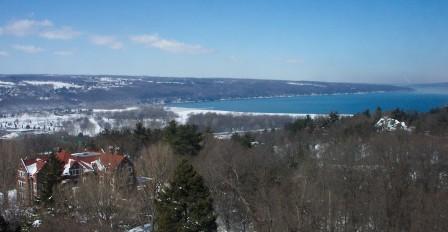Barnie Fife, speaking from the Great Beyond (or on a breather between reruns?) left a comment on my next to the last post. Apparently my living in Rochester, New York fills him with wonder.
I never planned to move here. I moved here originally to attend a nearby college. Long story short, I fell in fascination with yet another complex but self-destructive individual (a tendency I’ve curbed at last now by adhering to a policy of social isolation, *sob*). Ended up married because I once again failed to acknowledge the taint of doom tickling my nostrils. (I guess that makes it mutually assured self-destruction? LOL) Now I have a wonderful kid. We’re in a great school district, her dad is here, and yeah, I chafe sometimes in the reins but I’m a big girl now.
That said, Rochester is also a great city in a lot of ways. The traffic is manageable — for example you can live in a rural bedroom community, the sort of place where you can keep horses if you want, and your commute into downtown will still be only a half hour or so. My neighborhood in particular is a little corner of paradise, aesthetically and small-c culturally — and I don’t have to be a zillionaire to live here, in a spacious circa 1920s home with hardwood floors and a fireplace. While our museums and sports teams are officially second tier, because we don’t have the demographics to support first tier, they’re high enough caliber to give kids a taste of what’s out there — i.e., the city is a suitable jumping-off spot for a kid with aspirations to make the world his home, if he has the inclination & chops.
And if you hanker for big city culture, the plane ride to NYC is only 45 minutes and thanks to JetBlue tickets can be had for under $100. Toronto is a three-hour drive.
We have great public parks. Mendon Ponds Park, for instance, has 30 miles of self-guided nature trails. You can be there from just about any place in the greater Rochester area within minutes. We’ve got the Erie Canal, great place to bike, jog, walk your dog. Since we’re in a temperate climate, you can mix up your outdoor activities seasonally (if you can’t fight it, have fun with it!)
We’ve got great healthcare, including a first-rate research hospital.
Our crime rates are well above the national average but not out of line with other Upstate New York cities.
We don’t have to worry about hurricanes or earthquakes, just snow and the occasional ice storm, but it’s like anywhere in that regard. Be smart and prepare yourself for self-dependence for a few days. At least your house won’t be smushed into a pile of sticks when it’s over.
The biggest downside is that because this is New York State, our taxes are ridiculous and our politicians are worse. At the local level, their moribund thinking has cost us the embarrassment of the so-called Fast Ferry; shamelessly, they’ve put that behind them (despite the fact that the damn thing is still in dry dock here, apparently unsaleable) to push the so-called Renaissance Square down our throats (new post coming up on that shortly).
I’m sure there’s more that’s good about this city but this gives a taste. Despite its flaws, if I were a young married couple planning a family, Rochester would top my list of places to live.
That said, me personally? I don’t know where I’ll end up once my kid has flown the nest. I can work from anywhere, so I’m not tied to any location for income. I’d like to be in a relationship again someday, that will probably influence my choice. I’d like to be able to golf year-round. I ache sometimes to smell the ocean. But I also love the flora/fauna of the Northeast — the hardwood forest, and the geography, the hills. I’d like to stay close enough to a world-class city to jump in regularly for a visit but I also need a base somewhere with space and trees & a bit of privacy.
So who knows? But I guess not knowing is part of the fun of it . . .

